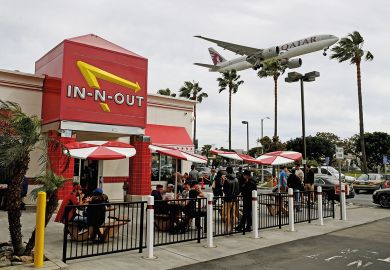Some US universities will inevitably become “more aggressive” in their overseas student recruitment in the coming years, causing disruption domestically as well as abroad, according to a consultant.
Matt Durnin said that while international education had never been a “front of mind” issue in the US, demographic and financial pressures would force “certain segments” of the country’s massive higher education sector to increase their foreign intakes.
This would “challenge” other leading study destinations, such as the UK and Australia, but the likely reaction of US immigration policy and authorities was “an open question”, he said. “It’s inevitable that…US universities and colleges are going to get pushed into this space more, [but] I think it will be a bumpy road.”
Mr Durnin is a Toronto-based principal with consultants Nous Group. He spent 15 years in Beijing working for The Economist, the Financial Times and, ultimately, the British Council, where he was global head of insights and consultancy.
He said sharp growth in international student numbers – particularly at lesser-ranked institutions – tended to elicit a “policy response”, and there was evidence that this had already happened in the US.
Washington DC thinktank the Cato Institute has reported that student visa rejection rates rose from about 20 per cent in 2021 to 36 per cent in 2023. It said the US Department of State had refused more than a quarter of a million student visas last year, costing the country’s economy some $30.4 billion (£23 billion).
Mr Durnin said international education had never been as politicised in the US as it is elsewhere, partly because foreign students were a small component of the country’s net migration figures, and partly because US universities had never been as financially reliant on international enrolments as their Australian and British counterparts.
But this could change, with some institutions – notably the universities of Arizona and West Virginia – experiencing “financial distress”. Meanwhile, the decline in school-leaver numbers was especially pronounced in regions favoured by international students, particularly the East Coast.
Mr Durnin said that if the US were to become “a more ambitious study destination”, visa applications would “overwhelm” authorities’ capabilities. “They’d either have to hire a lot more people to manage it, or adopt systems like the UK and Australia [in] putting more of the compliance burden on the universities.”
He said the students most likely to secure US visas were those most desired by its competitors. “Inevitably, if the US grows, it’s going to take away a larger portion of the students who would have a relatively easy time getting through immigration barriers in the other countries as well.”
That included people from China and “relatively low-risk” applicants from India, which had overtaken China as the US’ top international student source market in 2022.
Mr Durnin said recent bills to enhance post-study employment rights were in keeping with longstanding support for the “optional practical training” programme, which allows international graduates to stay in the US for between one and three years to work in areas directly related to their qualifications. “Optional practical training has only been broadened as a policy – it’s never really been restricted or rolled back.”
He said competitor countries should work harder to promote international graduates to employers. “All the study destinations are going to need to get a lot more serious about…making post-study work pay off for students, and really demonstrating the potential benefits to the economy.”
Register to continue
Why register?
- Registration is free and only takes a moment
- Once registered, you can read 3 articles a month
- Sign up for our newsletter
Subscribe
Or subscribe for unlimited access to:
- Unlimited access to news, views, insights & reviews
- Digital editions
- Digital access to THE’s university and college rankings analysis
Already registered or a current subscriber?










